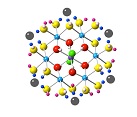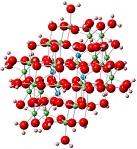Multicopper manganese oxidase accessory proteins bind Cu and heme
Abstract: Multicopper oxidases (MCOs) catalyze the oxidation of a diverse group of metal ions and organic substrates by successive single-electron transfers to O2 via four bound Cu ions. MnxG, which catalyzes MnO2 mineralization by oxidizing both Mn(II) and Mn(III), is unique among multicopper oxidases in that it carries out two energetically distinct electron transfers and is tightly bound to accessory proteins. There are two of these, MnxE and MnxF, both approximately 12 kDa. Although their sequences are similar to those found in the genomes of several Mn-oxidizing Bacillus species, they are dissimilar to those of proteins with known function. Here, MnxE and MnxF are co-expressed independent of MnxG and are found to oligomerize into a higher order stoichiometry, likely a hexamer. They bind copper and heme, which have been characterized by electron paramagnetic resonance (EPR), X-ray absorption spectroscopy (XAS), and UV–visible (UV–vis) spectrophotometry. Cu is found in two distinct type 2 (T2) copper centers, one of which appears to be novel; heme is bound as a low-spin species, implying coordination by two axial ligands. MnxE and MnxF do not oxidize Mn in the absence of MnxG and are the first accessory proteins to be required by an MCO. This may indicate that Cu and heme play roles in electron transfer and/or Cu trafficking.
Cristina N. Butterfield, Lizhi Tao, Kelly N. Chacón, Thomas G. Spiro, Ninian J. Blackburn, William H. Casey, R. David Britt, Bradley M. Tebo,Multicopper manganese oxidase accessory proteins bind Cu and heme, Biochimica et Biophysica Acta (BBA) - Proteins and Proteomics, Volume 1854, Issue 12, December 2015, Pages 1853-1859.



